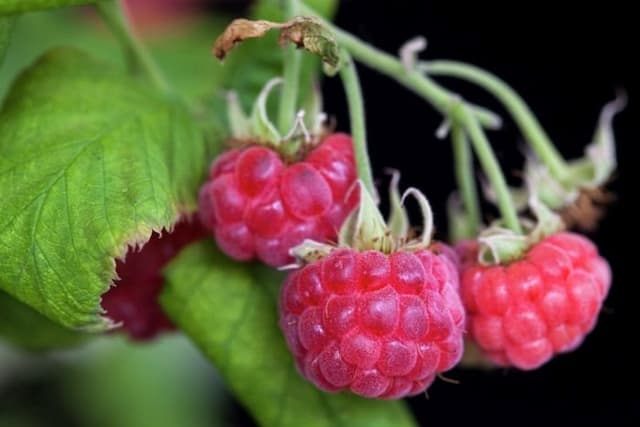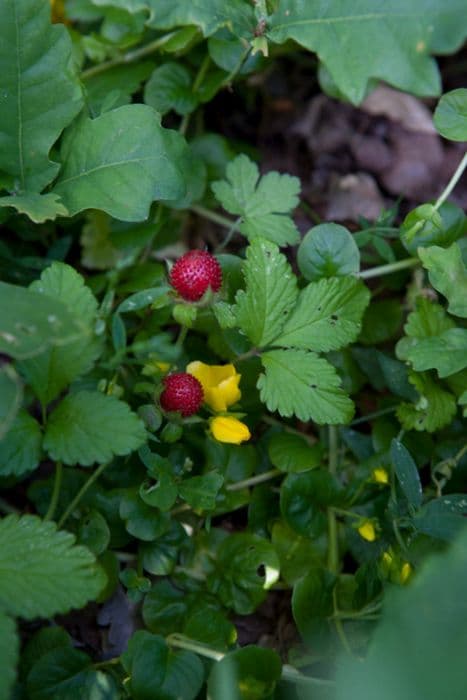Purpleleaf Plum Prunus cerasifera 'Nigra'

ABOUT
The plant commonly known as the Purple-leaf plum is a striking ornamental tree best known for its captivating foliage and early spring flowers. The leaves emerge with a rich purple hue that captures the eye, creating a bold contrast with the greens typical in a garden landscape. As the seasons change, the leaves may transition to a deep green with purple undertones, maintaining a certain depth and interest throughout its seasonal cycle. In early spring, the Purple-leaf plum tree erupts into a flourish of blossoms. The flowers are usually a light pink to white color, creating a soft and beautiful cloud around the branches. This burst of florals arrives before the leaves fully unfurl, offering a bright, celebrated showcase of petals that can enliven any outdoor space. The overall appearance of the Purple-leaf plum is one of elegance and charm, with its distinct foliage color and the poetic presence of its delicate flowers. It brings a lovely ambiance to any landscape setting, bolstered by the rich, dark hue of its leaves that remains visually compelling even when the tree is not in bloom.
About this plant
 Names
NamesFamily
Rosaceae.
Synonyms
Purpleleaf Plum, Black Cherry Plum, Purple Cherry Plum, Purple Leaved Plum, Redleaf Plum, Blireiana Plum.
Common names
Prunus cerasifera var. atropurpurea, Prunus cerasifera 'Pissardii', Prunus cerasifera 'Atropurpurea', Prunus pissardii.
 Toxicity
ToxicityTo humans
The most common common name for Prunus cerasifera 'Nigra' is Purple-leaf plum. This plant is not considered highly toxic to humans; however, all parts of the plant, except the ripe fruit, contain cyanogenic glycosides, which can be harmful if ingested in large quantities. These compounds can break down into cyanide when digested. Symptoms of cyanide poisoning include headache, dizziness, confusion, weakness, difficulty breathing, and potentially leading to coma or death in severe cases. It is rare for humans to consume enough plant material to cause serious harm, as the bitter taste of the toxic parts often deters significant ingestion.
To pets
The Purple-leaf plum can be toxic to pets if ingested, as it contains cyanogenic glycosides, primarily in the leaves, stems, and seeds. When pets chew or eat these parts of the plant, the compounds can break down into cyanide in the body. Symptoms of cyanide poisoning in pets may include panting, difficulty breathing, dilated pupils, browning of the gums, shock, and in severe cases, coma or death. The ripe fruits are generally not considered toxic, but ingesting large amounts of the pits could lead to gastrointestinal obstruction or contribute to cyanide poisoning. It is crucial to prevent pets from accessing and ingesting any toxic parts of this plant.
 Characteristics
CharacteristicsLife cycle
Perennials
Foliage type
Deciduous
Color of leaves
Purple
Flower color
Pink
Height
20 feet (6 meters)
Spread
15 feet (4.5 meters)
Plant type
Tree
Hardiness zones
5
Native area
Balkans
Benefits
 General Benefits
General Benefits- Ornamental Value: Prunus cerasifera 'Nigra', commonly known as the Purple-leaved Plum tree, adds visual interest to landscapes with its dark purple to burgundy foliage and pink to white spring blossoms.
- Shade Provider: It grows into a medium-sized tree that offers shade in gardens and public spaces during hot summer months.
- Wildlife Attraction: The flowers provide nectar for pollinators such as bees, and the fruit can attract birds and other wildlife.
- Seasonal Interest: It has year-round interest with blossoms in spring, colored foliage in summer, and sometimes an attractive leaf color change in the fall.
- Compact Size: Being relatively small for a tree, it is suitable for urban gardens and areas with limited space.
- Privacy Screen: When planted in rows, it can act as a privacy screen or windbreak.
- Low Maintenance: Once established, it requires minimal care, making it a good choice for low-maintenance landscaping.
- Erosion Control: The root system can help stabilize slopes and prevent soil erosion.
 Medical Properties
Medical PropertiesThis plant is not used for medical purposes.
 Air-purifying Qualities
Air-purifying QualitiesThis plant is not specifically known for air purifying qualities.
 Other Uses
Other Uses- Photography Backdrops: The captivating deep purple leaves and delicate pink blossoms of the Purple Leaf Plum tree can provide a stunning background for portrait photography and enhance the visual appeal of outdoor photoshoots.
- Educational Tool: Botany students and educators can use the Purple Leaf Plum tree to demonstrate grafting techniques or to discuss the genetic variations that give the tree its distinctive coloration.
- Bonsai Specimen: The Purple Leaf Plum tree can be cultivated as a bonsai, offering enthusiasts a chance to shape and display the tree's striking features on a miniature scale.
- Artistic Inspiration: Artists may draw inspiration from the tree's contrasting foliage and blooms, using it as a subject for paintings, drawings, or other artistic endeavors.
- Culinary Garnish: Although not commonly consumed, the blooms from the tree can occasionally be used as an edible garnish for spring dishes, adding a splash of color to the presentation.
- Craft Material: Branches and blossoms can be used in floral arrangements, wreath-making, or other crafts to add natural beauty and a unique color palette.
- Festival Decor: During blooming season, branches can be cut and used as a part of decorative setups for festivals or special occasions, especially those celebrating springtime.
- Honey Production: Bees are attracted to the flowers, and while specific foraging on the tree might not be encouraged, it can help support local bee populations and contribute to diverse honey production.
- Nature Studies: As a favored nesting site for some bird species, it can be used in bird-watching activities, helping to teach about avian habits and the importance of habitat.
- Landscape Contrast: In urban and suburban planning, this tree serves as a visual contrast amid traditional greenery, which can break the monotony of the urban landscape.
Interesting Facts
 Feng Shui
Feng ShuiThe Purple Leaf Plum Tree is not used in Feng Shui practice.
 Zodiac Sign Compitability
Zodiac Sign CompitabilityThe Purple Leaf Plum Tree is not used in astrology practice.
 Plant Symbolism
Plant Symbolism- Renewal and New Beginnings - The Prunus cerasifera 'Nigra', commonly known as the 'Purple-leaf plum tree', often blossoms early in spring, symbolizing the end of winter and the arrival of new life.
- Innocence and Purity - The delicate white to pale pink flowers of the Purple-leaf plum tree represent purity and innocence, often associated with the beauty of nature in its unspoiled state.
- Youthful Enthusiasm - With its vibrant purple leaves and abundant blossoms, the Purple-leaf plum tree is often seen as a symbol of youthful vitality and the energetic bloom of youth.
- Love and Fertility - In some cultures, plum blossoms are associated with love and fertility, potentially due to their springtime blooming period which coincides with themes of growth and renewal.
 Water
WaterThe Purple Leaf Plum Tree should be watered deeply once or twice a week, depending on the weather conditions; during hot or dry spells, you may need to water more frequently. Use a soaker hose or drip irrigation to deliver water directly to the base of the tree, promoting deep root growth and avoiding wet foliage, which can lead to disease. Generally, provide about 5 gallons of water per week for an established tree, adjusting as necessary for younger trees with less established root systems. It is crucial to water the tree more sparingly as it becomes dormant in the fall and to ensure the soil is well-drained to prevent root rot.
 Light
LightThe Purple Leaf Plum Tree thrives best in full sunlight. It requires a minimum of six hours of direct sunlight each day to ensure vibrant foliage color and optimize fruit production. The tree should be planted in a spot that is unobstructed by taller trees or buildings to get consistent sun exposure throughout the day.
 Temperature
TemperatureThe Purple Leaf Plum Tree can tolerate a range of temperatures but thrives in USDA hardiness zones 4 through 9, which means it can withstand temperature lows down to -30°F and highs well above 100°F. Ideal temperatures for this tree are between 60°F and 85°F. It is cold-hardy and can recover well from brief cold snaps but may need protection from prolonged extreme cold or heatwaves.
 Pruning
PruningThe Purple Leaf Plum Tree should be pruned to remove any dead or damaged branches, to keep the tree's shape, and to encourage new growth. Pruning should be done in late winter or early spring before new growth begins to prevent infection and to allow for a quick recovery. Typically, it is enough to prune the tree every 2 to 3 years, but inspect annually for any necessary cleanup.
 Cleaning
CleaningAs needed
 Soil
SoilThe Purple Leaf Plum tree requires well-drained soil enriched with compost. A mixture consisting of loam, peat, and sand in equal parts is ideal. The soil pH should be between 5.5 and 7.5 for optimal growth.
 Repotting
RepottingPurple Leaf Plum trees are typically outdoor plants and do not require repotting. However, if grown in a container for a bonsai or decorative purposes, repotting every 3-5 years is sufficient to refresh the soil and encourage healthy growth.
 Humidity & Misting
Humidity & MistingPurple Leaf Plum trees are adaptable to a range of humidity conditions outdoors and do not require specific humidity levels to thrive.
 Suitable locations
Suitable locationsIndoor
Not ideal for indoors; requires full sun and space to grow.
Outdoor
Plant in full sun, fertile soil, water regularly, monitor pests.
Hardiness zone
4-9 USDA
 Life cycle
Life cycleThe life cycle of the 'Nigra' Cherry Plum, or Prunus cerasifera 'Nigra', begins with germination, which occurs when the conditions are right—warm temperatures and moist soil. The seedling emerges and starts its growth phase, developing roots and shoots. As the shoot develops leaves and branches, the young sapling matures over several years into a flowering tree, marked by spectacular spring blossoms that can range from pale pink to white. Following pollination, often by bees or other insects, the flowers develop into small plums, which, if conditions are favorable, will mature through the summer. Once the plums are ripe, they are dispersed by various means such as by animals or gravity, allowing the seeds within to potentially germinate and begin a new cycle. Throughout its life, the 'Nigra' Cherry Plum will go through repeated cycles of growth, flowering, and fruiting, often living for several decades.
 Propogation
PropogationPropogation time
Spring
The most popular way to propagate the plant commonly known as Purple-leaf Cherry Plum, or Prunus cerasifera 'Nigra', is by taking semi-hardwood cuttings during the summer. To do this, gardeners should select healthy, non-flowering stems from the current season's growth. These stems are cut into lengths of 4 to 6 inches (approximately 10 to 15 cm), ensuring that each cutting includes at least two sets of leaves. The lower leaves are removed, and the cut end is dipped into rooting hormone to encourage root development. The prepared cuttings are then planted into a well-draining potting mix or directly into the ground in a shady, protected area. The soil must be kept moist, but not waterlogged, until roots develop, which typically takes several weeks. Once established, the rooted cuttings can be transplanted to their desired location in the garden.









